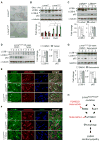Temsirolimus activates autophagy and ameliorates cardiomyopathy caused by lamin A/C gene mutation
- PMID: 22837537
- PMCID: PMC3700376
- DOI: 10.1126/scitranslmed.3003875
Temsirolimus activates autophagy and ameliorates cardiomyopathy caused by lamin A/C gene mutation
Abstract
Mutations in the lamin A/C gene (LMNA), which encodes A-type lamins, cause a diverse range of diseases collectively called laminopathies, the most common of which is dilated cardiomyopathy. Emerging evidence suggests that LMNA mutations cause disease by altering cell signaling pathways, but the specific mechanisms are poorly understood. We show that the AKT-mammalian target of rapamycin pathway is hyperactivated in hearts of mice with cardiomyopathy caused by Lmna mutation and that in vivo administration of the rapamycin analog temsirolimus prevents deterioration of cardiac function. We also show defective autophagy in hearts of these mice and demonstrate that improvement in heart function induced by pharmacological interventions is correlated with enhanced autophagy. These findings provide a rationale for treatment of LMNA cardiomyopathy with rapalogs and implicate defective autophagy as a pathogenic mechanism of cardiomyopathy arising from LMNA mutation.
Conflict of interest statement
Figures




References
-
- Dauer WT, Worman HJ. The nuclear envelope as a signaling node in development and disease. Dev Cell. 2009;17:626–638. - PubMed
-
- Hernandez L, Roux KJ, Wong ES, Mounkes LC, Mutalif R, Navasankari R, Rai B, Cool S, Jeong JW, Wang H, Lee HS, Kozlov S, Grunert M, Keeble T, Jones CM, Meta MD, Young SG, Daar IO, Burke B, Perantoni AO, Stewart CL. Functional coupling between the extracellular matrix and nuclear lamina by Wnt signaling in progeria. Dev Cell. 2010;19:413–425. - PMC - PubMed
-
- Cao K, Graziotto JJ, Blair CD, Mazzulli JR, Erdos MR, Krainc D, Collins FS. Rapamycin reverses cellular phenotypes and enhances mutant protein clearance in hutchinson-gilford progeria syndrome cells. Sci Transl Med. 2011;3:89ra58. - PubMed
Publication types
MeSH terms
Substances
Grants and funding
LinkOut - more resources
Full Text Sources
Other Literature Sources
Medical
Molecular Biology Databases
Miscellaneous

